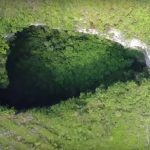A True Story Of a Shocking Discovery
Thanks to the Jurassic Park franchise, people are fascinated with dinosaurs. A man in Alberta, Canada was on the job digging in the sand one day and found something shocking. The man was digging through the sand only to notice something that you don’t even see in the movies.
An Ordinary Day
Shawn Funk worked as a heavy machine operator. For the last 12 years, he had been working for an energy company called Suncor. His job sent him to the Millennium Mine in Fort McMurray, Alberta. The job was difficult, but Shawn enjoyed it. He operated an excavator. He was so experienced on the machine that he could often do the job with his eyes closed. During his career, he never found anything special. The most exciting thing that he ever found was some fossilized wood. When he was working in Fort McMurray on this day, he was shocked by what he found.
The Day Of the Find
Everything changed for Shawn on the afternoon of March 21, 2011. The whole morning, he was digging away in his excavator. While digging, he was pulling up the remains of a few marine plants that have been in the ground for years. It was assumed that the plants existed over 110 million years ago. Things like this didn’t shock Shawn, so he kept digging. It wasn’t until 1:30 that afternoon that Shawn’s bucket clipped something much harder than the surrounding ground.
Irregular Surroundings
When the bucket clipped the hard surroundings, Shawn looked down to see what he was digging into. He saw oddly colored lumps that had tumbled out of the till. He tried to get a better look, but it slid down back into the back below. Shawn wasn’t sure what to do so he decided to go get his supervisor, Mike Gratton. When the two men went to the site, they saw walnut brown rocks. They were like nothing they had ever seen before. Shawn had seen fossilized wood in the past, and he wasn’t sure that this was what it was. The two men decided to dig a bit deeper to see what they had recovered.
Digging Deeper
The two men turned over the lumps, and they saw that they had a strange pattern. What they found contained row after row of sandy brown discs. Each of the discs was ringed in a stone that was a gunmetal gray. They could have ignored the find and continued on with the dig to get the job done quickly, but both men decided against that. They said that since it was nothing like they had ever seen before, they should have it checked out.
Calling In the Experts
Shawn and Mike were sure that they had found something archaeological. Mike contacted his supervisor to report the discovery. His supervisor ordered him to suspend the dig. Soon, the Suncor higher-ups called in experts from the Royal Tyrrell Museum. They were sure that someone there could identify the rocks. This was normal for construction crews in Alberta. They were trained to call the museum anytime they found something that didn’t look like sand. Since the oil sand in Alberta is littered with fossils, this was normal for crews. In most cases, construction crews would find marine reptiles or plant line that had become fossilized. They had never uncovered something like this.
The Amazing Find
Donald Henderson, the Curator of Dinosaurs, and Darren Tanke, a senior technician in the Fossil Preparation Lab went out to the site. It would be up to them to determine what Shawn had dug up. This wasn’t an easy job. They had a team working 12-hour shifts to finally get down to a 15,000-pound rock. When the specimen was isolated, it had to be lifted for transport. The team wrapped it in burlap and plaster for protection, and it was lifted up out of the bank. Unfortunately, the burlap wasn’t strong enough, and it tore. The rock dropped and hit the ground and shattered. Fortunately, it splintered into large chunks that could be put back together later. Finding a way to get the rock safely to the museum became a difficult task.
On the Road
Tanke and Henderson realized that they would need to bring the huge hunks of rock to the museum on the road. The fragments were covered in plaster, and they came up with a plan to stabilize the fragments on the drive back to the lab. They decided to soak the burlap in plaster and then wrap the pieces like logs for transport. They had the specimen prepared for its 420-mile ride to the museum. Tanke’s and Henderson’s jobs were over. Now it was time for Mark Mitchell to start his part of the job. He was the museum’s best fossil preparator. He had years of work ahead of him.
Finally, Some Answers
It took years and hundreds and hundreds of hours of work, but Mark finally was able to get the specimen out of the rock. It was a dragon-like dinosaur fossil. It was an incredible find because the fingers and toes were still attached. The specimen seemed to be turning its head to the side. Experts believe that it turned its head to see the rushing river that was heading toward it. His report stated that is was the best-preserved fossil ever found in Alberta. It was so well-preserved that most of the skeleton was covered with fossilized skin.
How Did It Remain So Well Preserved?
According to experts, the dinosaur lived over 110 million years ago. It was an armored plant-eater that lived in what is now western Canada. They believe that the dinosaur was swept to the open sea when a river flooded. Because the dinosaur was buried under the sea, it preserved its armor in amazing detail. The species that they found was called a nodosaur and it was something that paleontologists had never seen. They had also never seen such a well-preserved fossil. What Shawn Funk uncovered that day gave experts a real idea of what these creatures looked like and how they moved.


